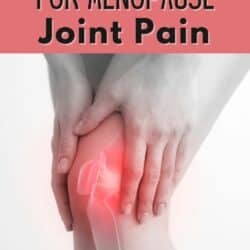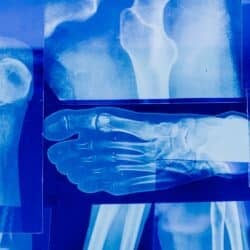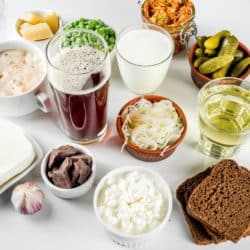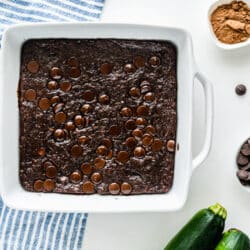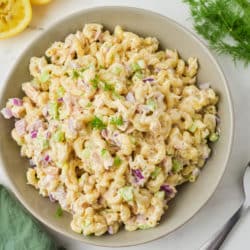9 Supplements for Menopause Joint Pain
Changes in hormone levels during perimenopause and menopause can lead to all sorts of symptoms, including an increase in joint pain. This article reviews supplements for menopause joint pain, including natural remedies.
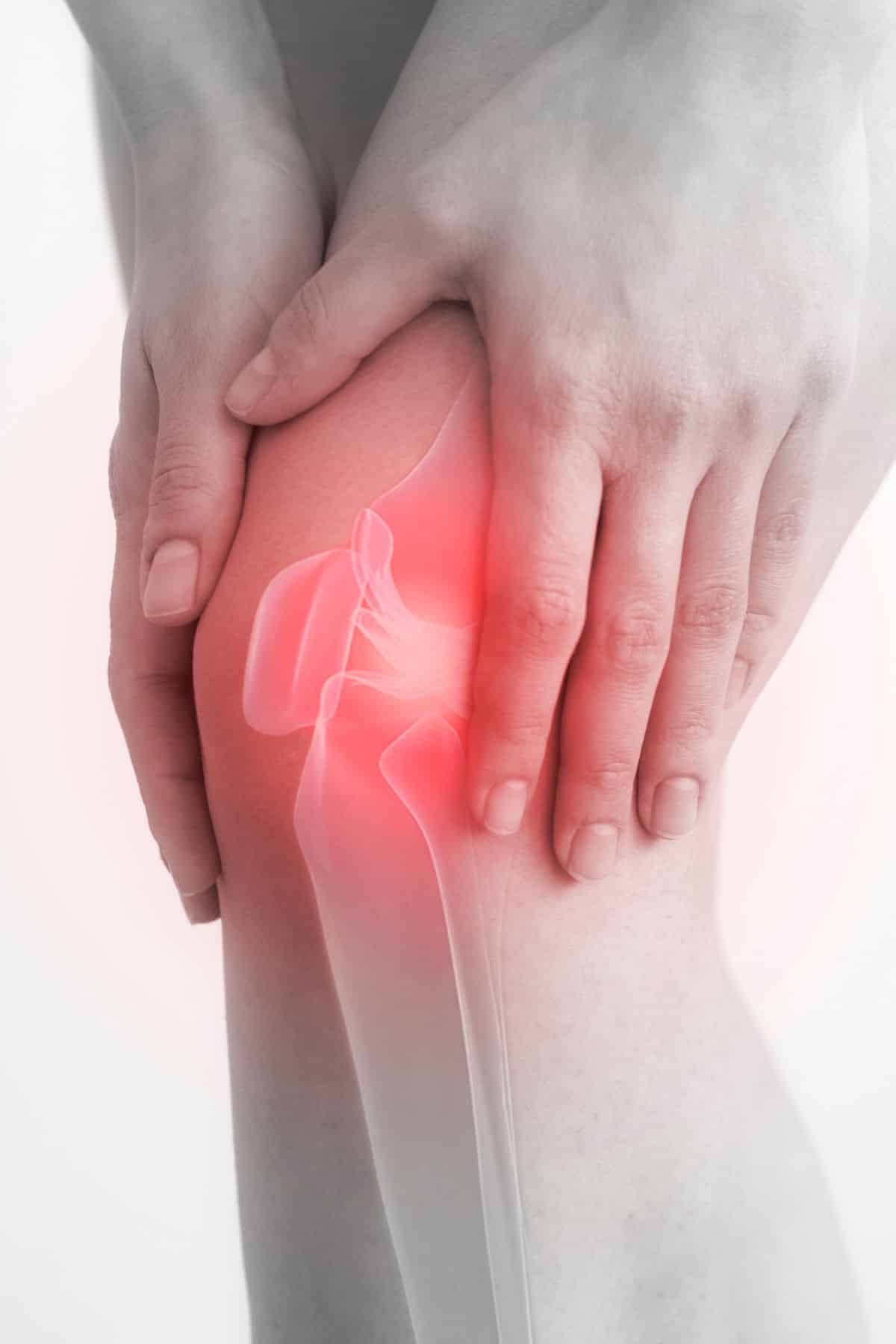
Menopause Pain
Joint pain during menopause is commonly caused by decreased estrogen levels. Treatments can include hormone replacement therapy, medications, lifestyle changes, and certain supplements.
In this article, we’ll review the best supplements to consider for menopausal joint pain, plus some natural lifestyle remedies as well.
These supplements include:
- Vitamin D
- Glucosamine and Chondroitin Sulfate
- Turmeric
- Fish oil
- MSM
- SAMe
- Magnesium
- Nettles
- Bioidentical Hormone Replacement
It’s crucial to consult with a healthcare provider before starting any new treatment or supplement regimen.
Supplements for Menopause Joint Pain
1. Vitamin D
Vitamin D plays a key role in bone health, immune health, and muscle function.
There hasn’t been any specific research into the relationship between vitamin D and menopausal joint pain. But, studies show that maintaining healthy vitamin D levels is helpful in avoiding joint pain in general – particularly when it is caused by inflammation.
What’s more, researchers have found that adults over the age of 50 and deficient in vitamin D are more likely to develop pain in their hips and knees. If the deficiency isn’t treated, this pain is likely to increase.
You can actually make vitamin D in your skin if you are exposed to enough sunlight. Depending on your skin color and how well your skin absorbs vitamin D, as little as 5 to 30 minutes of exposure (without sunscreen) at least twice per week can be sufficient.
But this isn’t always easy to achieve at certain times of the year, or if your lifestyle means you spend a lot of time indoors. As a result, many of us are deficient in this important nutrient.
In order to keep your levels topped up, you should aim to eat plenty of vitamin D-rich foods like egg yolks, liver, and fatty fish. It is likely that your healthcare provider will also recommend a vitamin D supplement.
Vitamin D is also great for helping to balance estrogen levels after menopause.
2. Glucosamine and Chondroitin Sulfate
The natural compound glucosamine is harvested from the hard covering of shellfish. Its most popular use is as a treatment for osteoarthritis, a condition caused by a breakdown and loss of cartilage triggered by inflammation.
Since menopause is associated with the onset of osteoarthritis, glucosamine can be useful in treating menopausal joint pain, particularly in the knees.
It helps by nourishing the damaged joint cartilage, which improves the joint’s mobility and slows the further progress of the condition.
This article that brought together evidence from two 3-year studies showed how a supplement of glucosamine sulfate reduced osteoarthritis progression in postmenopausal women with knee osteoarthritis.
However, glucosamine for joint pain is even more effective when combined with chondroitin sulfate. Like glucosamine, chondroitin sulfate has anti-inflammatory properties and can help prevent joint damage.
Used together, this powerful combination has been found to be as effective as NSAIDs (non-steroidal anti-inflammatory drugs) in relieving pain and stiffness. It is also considered safer, so it can be used more readily and should be considered when treating joint stiffness associated with menopause symptoms.
3. Turmeric
The spice turmeric is rich in a compound called curcumin. This has long been revered for its anti-inflammatory properties, which means that taking turmeric supplements during menopause can go a long way toward easing any related joint pain.
There are other benefits, too. Turmeric is a phytoestrogen, which means it has a mild estrogen-like effect on the body. This may help balance your hormones and help relieve other bothersome symptoms like hot flashes, mood swings, hot flushes, night sweats, and vaginal dryness.
Ideally, look for a turmeric supplement that contains black pepper extract or piperine. The pepper makes the turmeric easier for your body to absorb.
See my recipe for a Turmeric Shot with Pepper.
4. Fish oil
Fish oil is wonderfully beneficial for your joints and overall joint health. Flaxseed oil is a reasonable alternative if you are vegan or vegetarian, although it is not considered to be quite as effective.
Fish oil is rich in Omega-3 fatty acids. Eicosapentaenoic acid (EPA) and docosahexaenoic acid (DHA) in particular have been proven to be helpful in preventing joint inflammation. Again, these work in a similar way to NSAIDs but are considered safer long-term alternatives.
Some people experience a few side effects when taking fish oil, but there are ways in which to prevent them.
If you find that your fish oil supplements trigger acid reflux, then try splitting the oil into two doses, taking one in the morning and one at night. This can really help reduce symptoms. You can also try to increase you intake of oily fish such as sardines, anchovies, and salmon. See my recipe for Air Fryer Baked Salmon.
You should also take your supplements alongside – or just before – a meal, especially one containing fat. Not only does this help you absorb the oil more efficiently but it also makes it more effective.
5. MSM
MSM (methylsulfonylmethane) is an organic compound that occurs naturally in humans, plants, and animals. It can also be created in a laboratory to produce MSM supplements.
Up to now, it has mainly been seen as an alternative treatment. But there is compelling scientific evidence that it can ease joint pain. One study of 100 people aged over 50 found that a 3-month course of supplementation with MSM decreased swelling and discomfort while improving joint mobility.
Meanwhile, 49 people suffering from knee arthritis noticed an improvement in their physical function after taking MSM for the same period. This is because MSM works as an anti-inflammatory, inhibiting the proteins that are linked to inflammation.
Other benefits are that it helps to protect your cartilage as you age and boosts your levels of the antioxidant glutathione. And, when taken in combination with glucosamine and chondroitin, it can relieve pain more effectively than glucosamine and chondroitin alone.
For these reasons, MSM may be worth considering as part of your menopause supplements.
6. SAMe
SAMe – also known as ademetionine or S-adenosylmethionine – is a compound that we make in our bodies from methionine, an amino acid in foods.
A healthy body will make all the SAMe we need, but low folate, vitamin B12, or methionine levels can cause our SAMe to drop. In this situation, supplements are necessary.
SAMe is effective at reducing pain in the joints and researchers found it just as good as the NSAID celecoxib (Celebrex) in managing the symptoms of arthritis in the knees. The good news is that SAMe can provide this pain relief without unwelcome side effects.
SAMe may also help with mental health including depression that may impact everyday life after menopause.
7. Magnesium
Magnesium is a vital nutrient for your good health, supporting energy production and the function of your muscles and nerves. It also plays a key role in preserving your bone density and preventing osteoporosis.
Unfortunately, your magnesium levels drop during menopause. There are certain foods you can eat to boost them, including nuts, lentils, seeds, beans, whole grains, and dark chocolate.
But, your healthcare adviser may also recommend taking a magnesium supplement, particularly if you are experiencing pain in your joints.
And you’ll soon feel the benefits! Magnesium supplementation has been shown to help older adults exercise more efficiently and it has anti-inflammatory effects which help reduce pain and swelling.
See my article on the best types of magnesium.
8. Nettles
Throughout history, the stinging nettle has played an important part in medicine, used to treat everything from lower back pain to arthritis.
The leaves themselves may sting, but once they have been processed into a supplement, they can be taken safely.
Evidence into the efficacy of stinging nettle supplements is somewhat limited at this point. But there have been a couple of interesting studies that suggest their anti-inflammatory properties could make them useful in treating menopausal joint pain.
One, in particular, showed that people with arthritis found their symptoms eased so much that they were able to reduce the number of anti-inflammatory pain relievers they were taking.
9. Bioidentical hormone replacement
Joint pain during menopause is – in part – caused by the drop in estrogen levels. This, in turn, has a negative effect on your cartilage, the connective tissue that protects the ends of your bones.
Replacing the hormones that are at a low level during menopause can help relieve joint pain and other typical menopausal symptoms.
Bioidentical hormone replacement is different from traditional hormone replacement therapy. Rather than using synthetic hormones, it uses bioidentical hormones that are designed to be as close to those usually produced in the human body as possible.
Although there is no evidence to support this, the purpose of taking bioidentical hormones is to avoid unwanted side effects, since these hormones are designed to be more easily recognized by your body.
Natural Remedies for Menopause Joint Pain
1. Anti-inflammatory diet
Eating healthy foods that have anti-inflammatory benefits is a great way to limit your joint pain. There are two diets in particular with anti-inflammatory benefits – the Mediterranean diet and the DASH diet.
The Mediterranean diet is the most well-known, whereas the lesser-known DASH (Dietary Approaches to Stop Hypertension) diet was originally designed to bring down high blood pressure levels
Anti-inflammatory foods common to both diets include:
- Fruits and vegetables
- Fish
- Whole grains
- Poultry
- Olive oil
- Nuts and seeds
- Legumes
- Eggs
The DASH diet also involves choosing fat-free or low-fat dairy products and limiting foods that are high in saturated fat. These include full-fat dairy products, fatty meats, and tropical oils like palm kernel, coconut, and palm oils.
See my full list of healthy foods to eat daily.
A side benefit of focusing on a healthy diet during hormonal changes is that you can help prevent weight gain that is so often one of the symptoms of menopause.
2. Low-impact exercise and flexibility training
Exercise may be the last thing you want to do if you are suffering from joint pain, but gentle physical activity can significantly improve your mobility and relieve stiffness.
It can also help keep your weight under control, taking some of the pressure off those aching joints.
As you gradually incorporate low-impact exercise into your daily life, the muscles supporting your joints will strengthen and the improvement in your pain levels will be very noticeable.
So what exactly is low-impact exercise?
Basically, it’s any form of physical activity that involves fluid movements and doesn’t place stress on your joints. This rules out movements like jumping, which require you to brace yourself against impact.
Good, low-impact exercises and physical activities to try include:
- Yoga
- Pilates
- Swimming
- Cycling
- Spinning
- Dancing
- Tai Chi
You may also want to check out my article on the best exercise for chronic pain.
3. Reduced intake of added sugars
Sugar is one of the main causes of inflammation in the body so it’s very important that you keep your intake to a minimum.
Sugar exists naturally in many healthy foods like fruits and vegetables. But added sugar is found in processed food and drinks and has no nutritional value.
To avoid added sugars, choose clean foods like fresh produce, grains, and lean proteins for your meals and snacks. Try to eliminate processed foods as much as possible and choose water over sugary drinks.
See my tips to reduce sugar addiction, how to stop eating sugar, and my sugar-free diet plan.
4. Massage therapy
A good massage from a qualified therapist can release the muscles surrounding your joints and increase the blood flow, helping ease pain.
There are scientific studies to back up the benefits. In this one from Duke University, for example, people with osteoarthritis in their knees received a one-hour Swedish massage on a weekly basis for 2 months. At the end of that time, they reported an improvement in their mobility, less joint pain, and a better range of motion.
It’s a good idea to seek a therapist skilled in dealing with joint pain and check with your doctor first if you are concerned about what type of massage might be safe for you.
FAQs About Menopausal Joint Pain
During menopause, your estrogen levels drop.
This can be linked to the development of osteoarthritis, a condition caused by wear and tear to the joints due to the breakdown of the cartilage. (Note that this is not the same as rheumatoid arthritis, which is an autoimmune disease).
It is also believed that falling estrogen levels can have a negative impact on your muscular strength and the health of your tendons, both of which can cause pain in your joints. These issues can also make it hard to recover from training, which is why low-impact exercise is recommended during menopause.Not necessarily. For many women, menopausal joint pain will lessen as their bodies adjust to the new hormone levels after menopause. However, if the pain is due to arthritis triggered or worsened by menopause, it may be a long-term issue.
Post-menopausal women can still experience joint pain, especially if they have conditions like osteoarthritis. If the pain continues long after menopause or is severe, it’s important to see a healthcare provider to rule out other causes.
More Supplements and Nutrients to Consider
Conclusions
Painful joints during menopause can be miserable to live with and have quite an impact on your day-to-day activities. The good news is that there are many effective supplements you can try and simple lifestyle changes you can make to minimize the pain and feel like yourself again.
Don’t forget to join my newsletter list to get exclusive clean eating recipes and tips. The newsletter is 100% free with no spam; unsubscribe anytime.
About the Author: Carrie Forrest has a master’s degree in public health with a specialty in nutrition and is a certified holistic nutritionist. She is a top wellness and food blogger with over 5 million annual visitors to her site. Carrie has an incredible story of recovery from chronic illness and is passionate about helping other women transform their health. Send her a message through her contact form.
Note: this post is for informational purposes only and is not intended as medical advice. Please consult your healthcare provider for recommendations related to your individual situation.


